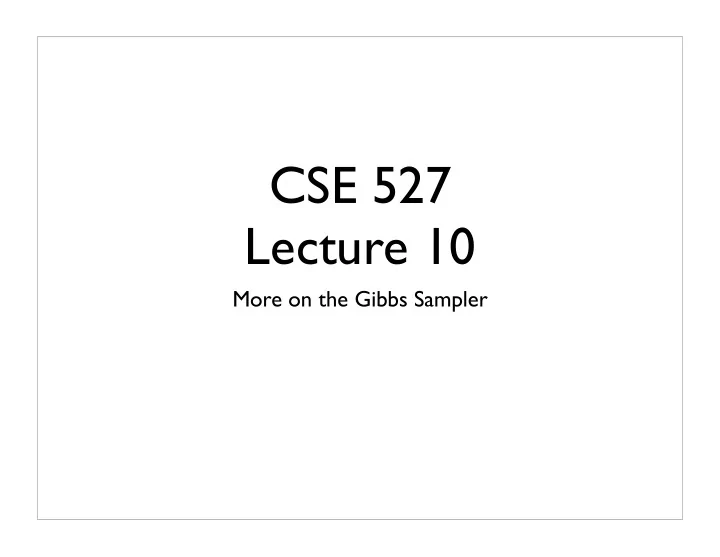

CSE 527 Lecture 10 More on the Gibbs Sampler
Projects – see web • Implementation or literature review • Small (interdisciplinary) groups preferred • Suggestion: • make a schedule • bite-size-pieces • Some ideas on web/by email & I’m happy to talk/listen/give (bad?) advice - send email
AlignAce (Roth, et al. 1998) • Lawrence et al.: protein motifs • Roth et al.: DNA regulatory motifs • Differences: • Genomic background model, e.g. yeast Saccharomyces cerevisiae is 62% A-T • both strands used • overlapping sites prohibited • Multiple motifs: find best & mask • “MAP” scoring; “specificity” scoring
Rocke & Tompa (Recomb ‘98) • Gibbs, adapted for gapped motifs • single “genomic” DNA sequence
Why Gaps • Biology often tolerates diversity • 2 similar TFs bind 2 similar sites • Same TF binds 2 sites (perhaps one better than the other) • Dimeric TFs often “don’t care” in middle & flexible • TF and/or DNA may twist/bulge
A Gapped Motif
Why gaps are hard • Alignment • Pairwise -- O(n 2 ) dynamic programming • Multiple -- O(n k ) • Gibbs/MEME/... require many alignments • Scoring
R/T Approach - Scores • WMM • Relative entropy, aka expected LLR • Score gaps like background, “minus a small penalty”
R/T Approach - Alignment • Gibbs replaces 1 string per iteration • Use pairwise alignment between new string and previously computed alignment of remaining k- 1 • Actually align motif against whole genome - Time O(genome length x motif width)
R/T Approach- “Gibbs” • discard 0-2 random strings at each iteration • pick replacement greedily, not by sampling; avoid local max by random restarts (see Rocke’s thesis for more on this)
Test Data • Haemophilus influenzae • ~1.8 megabases • Delete all protein-coding, leaves ~ 350 kb • Concatenate, separated with markers • Plus reverse complement, total ~ 700 kb
Motif width=10
A Motif + Context
Rewindowing • After convergence, “rewindow” -- choose subset of rows and adjust left/right boundaries to maximize score. • NP-hard? Use another greedy heuristic
Rewindowing
A closer look at 35 • 6 almost perfectly identical regions of 5.3 kb, each 3 rRNA genes plus some tRNA genes • 9% of genome but 50% of high-scoring motifs • removed 80kb containing them & re-ran
After Removal
More rewindowing 0 & 1 identical for another 55 bases; 5 differences in next 44. Probably not a TFBS, but not “random”
Summary • handles gaps • greedy “sampling” / random restarts • avoids full multiple alignment by exploiting good partial alignment • validation - null model for comparison • look at data - • rewindowing • rRNA cluster
Recommend
More recommend